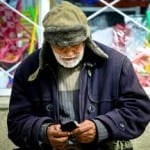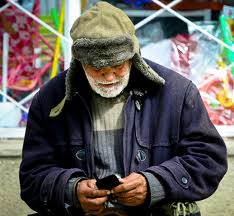 New research: Digital technology and homelessness
New research: Digital technology and homelessness
Voice and power for homeless and vulnerable people through new and emerging digital technologies
- VOICE – giving homeless people new opportunities to express themselves and their experience ‘as citizens’ to reach a public audience and to challenge cultural stereotypes
- DIALOGUE – facilitating new ways for homeless people to communicate ‘as consumers’ with service providers, redressing the power imbalance between them, and providing feedback to inform and shape service development
- SUPPORT NEEDS – providing live information feeds, ‘nudging’ take up, and reminding homeless people of appointments for housing, health, employment and welfare services
- CAPABILITIES – improving skills in numeracy and literacy for employment and enterprise, offering volunteering opportunities, and providing information on mainstream / high-street services that make day-to-day life easier, cheaper and safer
- SOCIAL NETWORKS – facilitating contact for homeless people with family members, peer networking and support, and creating new opportunities for friendships through shared-interests and social activities for happiness, well-being and life-enrichment.
Lemos&Crane working with Thames Reach and supported by the Lankelly Chase Foundation
Mobile and digital technology has become ubiquitous in society and is often held as a contemporary embodiment of – or even prerequisite for – social inclusion and connection. Smart phones, mobile internet and social networking sites provide a means of instantly reaching out to loved ones, accessing services and information and sharing your experiences, thoughts and feelings with the world. The digital age has radically transformed how we communicate, work and conduct our friendships and relationships.
The impact of digital technology upon the social, emotional and practical lives of homeless people and those experiencing exclusion and disadvantage, however, is unknown. Although recent research suggests that many homeless people carry a mobile phone and put great value on having access to the internet, little is known about how they typically use these resources. Furthermore, the potential to harness new and emerging digital technology to improve and enrich the lives of excluded people has not been comprehensively explored.
Lemos&Crane are working with homelessness charity Thames Reach to develop insight and guidance on how digital technologies can engage and empower homeless people. The research will explore how digital technology can be used to improve the lives of vulnerable people by giving them a voice, enhancing and expressing their capabilities, facilitating peer-to-peer support and making the services they receive more personalised and enabling.
The project intends to empower vulnerable people by uniting them with technology that could provide an autonomous voice, redress the power-balance between service providers and service users and embed excluded people within an enriching and supportive social network.
To find out more and to be kept informed with developments get in touch via info@lemosandcrane.co.uk
Tags: Homelessness


Just saw this article posted on my LinkedIn network and I made the following comment there:
What an interesting article. To be honest as I read it I was thinking to myself ‘there are whole sections of society I know very little about’. This idea – no doubt fraught with challenges to overcome – is such an obvious benefit to those in need, and I admire those people who are doing it.
Communication is the foundation for everything else that can come after and be built on it – once you take that step of placing a mobile in the hands of a homeless person, the opportunities to then provide human contact, assistance and potential solutions (for those that want it) are many. I should imagine the emotional outcome of simply having a device that allows a homeless person to talk to another human from their cardboard box under a bridge somewhere would be huge enough in itself. The practical person in me asks ‘how do they charge the battery, how do they control costs, what are the boundaries for usage?”, but I’m sure that is also catered for.
Well done Lemos&Crane and Thames Reach (and Lankelly Chase Foundation). I would be really interested in seeing the results.
Steve Punter
Auckland
New Zealand